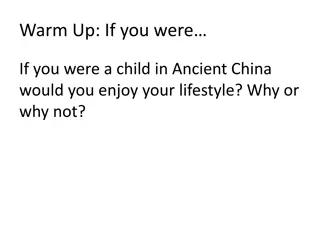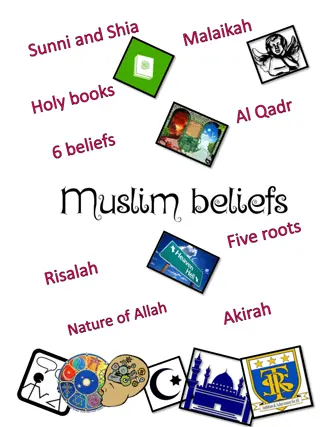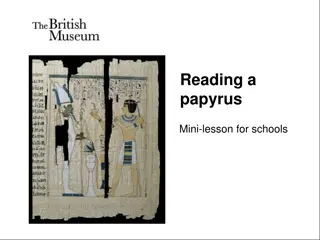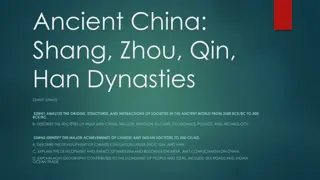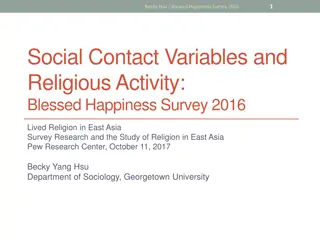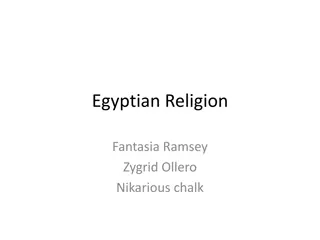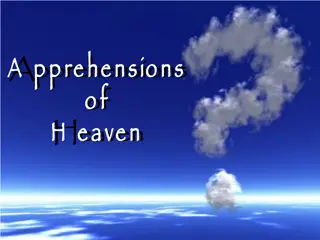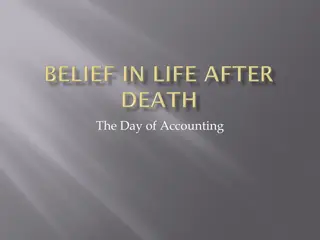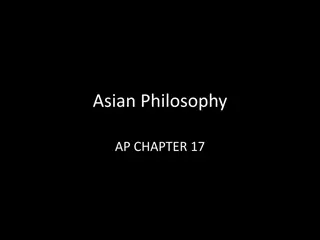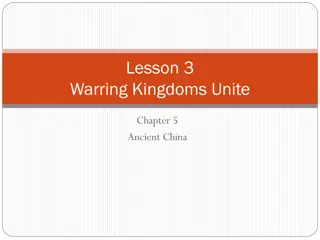Beliefs and Practices Surrounding Death and the Afterlife in Ancient China
Ghost stories and beliefs in ancient China revolved around souls crossing bridges to the afterlife, proper burial rites, and the dual nature of the soul (po and hun). The importance of honoring the gods, spirits, and ancestors through rituals and mournings was emphasized to prevent the return of souls to haunt the living.
Download Presentation

Please find below an Image/Link to download the presentation.
The content on the website is provided AS IS for your information and personal use only. It may not be sold, licensed, or shared on other websites without obtaining consent from the author.If you encounter any issues during the download, it is possible that the publisher has removed the file from their server.
You are allowed to download the files provided on this website for personal or commercial use, subject to the condition that they are used lawfully. All files are the property of their respective owners.
The content on the website is provided AS IS for your information and personal use only. It may not be sold, licensed, or shared on other websites without obtaining consent from the author.
E N D
Presentation Transcript
AUXILIARY PRACTICE MULTIPLE CHOICE PRACTICE
GHOST STORIES OF ANCIENT CHINA: BEWARE OF PO, HUN Ghost stories were the earliest form of literature in ancient China.They were almost certainly part of a very old oral tradition before writing developed during the Shang dynasty (1600-1046 B.C.) and they continue to be popular in China today.Ghosts were taken very seriously by the ancient Chinese.They had the power to harm whether one believed in them or laughed them off.
MORE STUFF TO READ!!!!!!!! When a person died their soul traveled across a bridge to the afterlife. They were judged as worthy or unworthy on this crossing. If they had lived a good life they continued on, but if they had done evil they fell from the bridge into hell. If they reached the other side, they were either reincarnated or reborn, or they went on to live with the gods, depending on one's beliefs. Buddhists believed that people were usually reincarnated, or born again on Earth. Confucians believed that the dead lived with the gods and could be prayed to for help. The first step in this journey after death was one's burial and funeral service, and if this was not done right the soul of the dead would return to haunt the living.
THE IMPORTANCE OF PROPER BURIAL THE IMPORTANCE OF PROPER BURIAL In China, the ground under the earth was considered the property of the gods. Cemeteries were located outside of towns and cities in rural areas, and there were earth spirits there known as Tudi Gong. One could not dig a grave without first honoring the gods and spirits who owned the land. Since it was hoped the dead person's soul would pass over the bridge to the land of the gods, grave goods were included in the burial, including favorite objects and food. The dead then had to be mourned for an appropriate amount of time. For parents and grandparents who died, one had to mourn them for at least three years. During this time one had to wear special mourning clothing and could not attend parties or listen to music. If any of these rules were broken, the soul of the dead would return to Earth.
THE PARTS OF THE SOUL THE PARTS OF THE SOUL There were two parts to the soul: the po and the hun. The po was the yin part of the soul, associated with darkness, water and Earth, and represented the animal nature of man, including instincts and urges. The hun was the yang part of the soul, associated with light, fire and the heavens, and represented reason and intelligence. These two parts of the soul worked together to make life possible for a person. The hun (reason) governed the po (instinct), but the hun needed the po in order to survive. After death, these two parts could return to cause problems for the living. This would happen if proper burial rites had not been observed or for other reasons such as unfinished business.
PO AND PO AND HUN HUN HAUNTINGS HAUNTINGS Stories of ghosts haunting a house where they once lived, haunting relatives or appearing to strangers for help are all examples of po hauntings. They occur because the yin is still attached to the Earth. This happens when mourners do not follow the proper practices for releasing the yin. Hun hauntings are different because the hun is not as attached to the body. Stories about spiritual possession or ghosts taking revenge on the living are examples of hun hauntings.
TYPES OF GHOSTS TYPES OF GHOSTS The po and the hun, when they returned to haunt the living, were generally known as guei. They usually returned because they were not buried properly. However, they could also return to seek revenge or to ask for help in righting a wrong. A particularly dangerous ghost was the shui gui (water ghost), which was the spirit of someone who had drowned and whose body was never given a proper burial. The shui gui haunted the waters where they died and lured people in to drown them. After their victim was dead, the shui gui could move on. The victim's spirit took its place and waited for the next person who could be caught off-guard. Small pieces of jewelry were worn to protect one from a shui gui when going near water or swimming.
The jiangshi was a kind of zombie ghost (the name means "stiff body") that would steal the breath from a person. The Chinese believed that breath, or qi, was the vital energy on which life depended. These spirits sought to steal it away for themselves. Jiangshi are also known as "hopping ghosts" because their spirit bodies are so stiff they seem to hop instead of walk.
The most famous type of ghost in China is the hungry ghost. This type emerged sometime after the first century when Buddhism came to China. Hungry ghosts are the spirits of people who always wanted more than they had and were never grateful for what they were given. They are often shown as people with enormous stomachs but tiny mouths and necks which no amount of food could ever fill. Hungry ghosts can appear as living people to ask for food. If one does not give them any, they can curse the person and bring disaster on their home and loved ones.
VIEWS OF GHOSTS AND PRACTICES VIEWS OF GHOSTS AND PRACTICES The ancient Chinese developed many practices and traditions to protect themselves from ghosts. The best defense was to live a good life,and this was why ghost stories were so often told to children. The stories express cultural values and encourage people to be kind and considerate to each other. A practice still observed in China today is the Ghost Festival, a celebration to appease the souls of the dead so they will not bother the living. It takes place during a time called Ghost Month. The Chinese believe that during this time the curtain between the dead and the living is drawn aside and the dead can cross back over.
CELEBRATIONS AND RITUALS OF GHOST CELEBRATIONS AND RITUALS OF GHOST MONTH MONTH There are many rules one must keep in mind during Ghost Month. One should not sit in the front rows at the theater because those are the seats the ghosts want and they will be offended. One should not place one's shoes facing the bed because ghosts will take it as an invitation to sleep there. One should not stay out too late or a ghost may follow one home (this is most often said by parents to their teenage children). Many shops close during the festival so that the ghosts will not be disturbed by living shoppers. As the festival ends, people light small lanterns, which they place on paper boats and send off on the water. The lanterns let the ghosts know that their time of visiting with the living is over and they have to return to the underworld. The ghosts are thought to follow the lanterns back home to the afterlife. When a lantern goes out, it is a sign that the ghost following it has reached the other side and is at peace.
WHICH STATEMENT WOULD BE MOST IMPORTANT TO INCLUDE IN A SUMMARY OF THE ARTICLE? A) People in ancient China were required to mourn the death of a parent or grandparent for three years. B) The people in ancient China believed that a proper burial and funeral were essential to reaching the afterlife. C) The shui gui were only allowed to move on when they drowned another person in the water that they haunted. D) During Ghost Month, the Chinese leave the front rows of theaters open so that ghosts will have a place to sit.
WHICH STATEMENT WOULD BE MOST IMPORTANT TO INCLUDE IN A SUMMARY OF THE ARTICLE? A. During this time one had to wear special mourning clothing and could not attend parties or listen to music. B. The victim's spirit took its place and waited for the next person who could be caught off- guard. C. A practice still observed in China today is the Ghost Festival, a celebration to appease the souls of the dead so they will not bother the living. D. The Chinese believed that breath, or qi, was the vital energy on which life depended.
WHICH STATEMENT WOULD BE MOST IMPORTANT TO INCLUDE IN A SUMMARY OF THE ARTICLE? A. There were two parts to the soul: the po and the hun. B. This happens when mourners do not follow the proper practices for releasing the yin. C. The stories express cultural values and encourage people to be kind and considerate to each other. D. Ghosts were taken very seriously by the ancient Chinese.
WHICH STATEMENT WOULD BE MOST IMPORTANT TO INCLUDE IN A SUMMARY OF THE ARTICLE? A. There were two parts to the soul: the po and the hun. B. This happens when mourners do not follow the proper practices for releasing the yin. C. The stories express cultural values and encourage people to be kind and considerate to each other. D. Ghosts were taken very seriously by the ancient Chinese.
WHICH TWO OF THE FOLLOWING SENTENCES INCLUDE CENTRAL IDEAS OF THE ARTICLE? 1. The po and the hun, when they returned to haunt the living, were generally known as guei. 2. The Chinese believed that breath, or qi, was the vital energy on which life depended. 3. The ancient Chinese developed many practices and traditions to protect themselves from ghosts. 4. Many shops close during the festival so that the ghosts will not be disturbed by living shoppers.
WHICH TWO OF THE FOLLOWING SENTENCES INCLUDE CENTRAL IDEAS OF THE ARTICLE? A) 1 and 2 B) 1 and 3 C) 2 and 3 D) 3 and 4







